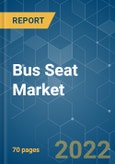The bus seat market is anticipated to register a CAGR of about 5% during the forecast period (2020 - 2025).
Key Highlights
- The rapid urbanization, growth in the international and national tourism industry, urban traffic congestion, shifting mobility patterns, and government promoting public transport are anticipated to fuel the demand for bus seats during the forecast period. Buses are one of the safest, convenient, greenest, most user-friendly, and affordable mode of transport for short and long-distance transport. In 2019, bus production decreased by 3.3%, to 271,204 compared to 280,387 in 2018, owing to the global economic crisis and the US-China trade war.
- Bus seats are noticing various technological advancements, as more and more electric and hybrid buses are being launched and adopted in different countries. Buses are shifting toward lightweight components and systems. Standard seats come with features, like the individual armrest, seat pockets, coat hanger. However, there is an increasing demand for light-weight seats with features, such as USB charging points, horizontal movement of seats, vertical grab handles on the seatback, and lumbar support.
- Various local governments have different innovative plans to promote public transport, such as providing free transportation. For instance, Luxembourg became the first country to make all its transportation free. Governments have plans to invest around USD 4 billion from 2018 to 2028, for the up-gradation of the bus network and for adding more park-and-ride sites in their borders. There are other major countries where free bus transportation is provided under certain conditions.
- The market is marked by several local players with intense competitive rivalry and margin pressure. Seat manufacturers are actively setting up alliances and expanding in the emerging markets, such as India and China, to take advantage of the low labor costs. This trend may change the dynamics of the industry during the forecast period. Furthermore, seat manufacturers must focus on these emerging markets to remain competitive.
Key Market Trends
E-bus is Driving the Bus Seat Market's Growth
Currently, China is the forerunner in the electric bus market. In 2018, nearly 23% of bus purchases in China were e-buses. Moreover, the overall bus purchases in the country are expected to remain stable, with more than 400,000 new purchases by 2025. Electric bus purchases are expected to increase, supported by continuous government initiatives to promote e-mobility, and the overall e-bus adoption is likely to reach 40% of new bus purchases globally, by 2040.
In 2020, the Los Angeles Department of Transportation (LADOT) announced its plans to place an order for 155 electric buses in the United States, which may be completed in two years. This purchase is a part of LADOT's ambitious plan of switching entirely to 100% electric buses by 2028.
In 2020, the European Commission approved USD 332 million of additional state funding in Germany, with a total funding of USD 719 million for incentivizing electric bus orders by the end of 2021.
BYD, one of the leading electric bus manufacturers headquartered in China, has sold more than 500 electric buses in Southern California. Its customers include airports, universities, private operators, and transit agencies.
Asia-Pacific is Expected to Lead the Bus Seat Market
Asia-Pacific is anticipated to lead the global bus seat market over the forecast period. This region has the presence of major market participants. Bus manufacturers, such as Anhui Ankai Automobile Company, Tata Motors, Ashok Leyland, Xiamen King Long United Automotive Industry, BYD Auto Co. Ltd, along with seat manufacturers, such as Aisin Seiki Co., Harita Seating Company, and Toyota Boshoku Corp., are present in the region.
Additionally, this region is witnessing an increase in the orders for electric buses placed by the local governments. For instance,
- In 2019, in India, Tata Motors announced that it won the contract to supply 300 electric buses to the government. The company had previously delivered 200 electric buses to the local government.
- China''s Zhongtong Bus Holding Co. Ltd and the Malaysian automotive manufacturer, Terus Maju Services (TMS), signed an agreement to develop energy buses for the Southeast Asian market.
Competitive Landscape
The major players in the market studied include Franz Kiel GmbH, Lazzerini SRL, Grammer AG, and Freedman Seating Company. The companies are expanding their presence through strategic alliances, the acquisition of regional players, and the introduction of advance and comfortable seats. For instance,
- In 2019, Lazzerini SRL, an Italian seat manufacturer, acquired Australia-based Styleride Seating Systems. This acquisition may drive the growth of the markets in Australia, New Zealand, and Asia during the forecast period. Lazzerini SRL has a rich customer base, which includes bus manufacturers, such as Alexander Wright, Volvo, Scania, Caetano, Iveco, Sitcar, Mussa, and IIA.
Additional Benefits:
- The market estimate (ME) sheet in Excel format
- 3 months of analyst support
This product will be delivered within 2 business days.
Table of Contents
Companies Mentioned (Partial List)
A selection of companies mentioned in this report includes, but is not limited to:
- TACHI-S Co. Ltd
- Commercial Vehicle Group Inc.
- Franz Kiel GmbH
- Grammer AG
- Freedman seating company
- Harita Seating Company
- Magna International Inc.
- Toyota Boshoku Corporation
- Prakash Seating Private Ltd
- Lazzerini SRL








